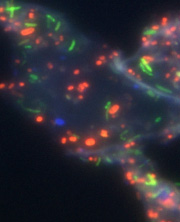Dietary Fibre And Gut Health
Published on 5 November 2009 in Food, health and wellbeing
Introduction
It is widely accepted by policy makers and by the public that dietary fibre is beneficial to human health. Not surprisingly an increasingly wide variety of food ingredients, including for example prebiotics and modified starches, are being developed and marketed that purport to deliver the benefits associated with dietary fibre.
It should be recognised however that the relative merits of different forms of fibre, and even the definition of dietary fibre, are the subject of considerable debate among nutritional scientists. Fibre is dietary material that survives digestion in the upper gut to reach the large intestine, where many of its benefits derive from the effects that it has on resident gut micro-organisms.
A much better understanding of the interactions between fibre, microbes and the human body is needed if we are to offer properly informed nutritional messages, and assess health claims for food products based in fibre.
Key Points
- Our research shows that the type and quantity of fibre in the human diet has a major impact on the balance of bacterial species in our colon and upon gut metabolites that influence health.
- Some of the bacteria that respond to fibre are quite well-known, but most are uncultured, or have only recently been isolated.
- Individuals can vary widely in their responses to fibre intake.
Research Undertaken

Figure shown: Different groups of commensal bacteria are visualized using fluorescent probes (showing up as red or green cells)
Policy Implications
- Different types of ‘fibre’ may exert profoundly different effects upon the large intestinal microbiota and upon health. This need to be recognised, and should ultimately be reflected in health messages to the public.
- Dietary advice needs to be tailored to the individual to take account of common chronic health problems (overweight/ obesity, diabetes, irritable bowel syndrome) as well as variations in individual response.
- There is potential for health improvement through targeted manipulation of intestinal microbes based on understanding diet/ host/ microbe interactions.
- A wide variety of food products can be selected, modified or processed in order to deliver particular forms of fibre to the large intestine. Better scientific understanding will create opportunities to the food industry for new products and for promoting the health-enhancing properties of existing foods.
- Regulatory bodies (especially FSA and EU FSA) are regularly asked to approve novel food products that are based on delivery of dietary fibre. Better understanding of the impact of fibre in different groups of consumers is essential for informed decision making.
Author
Professor Harry Flint h.flint@abdn.ac.uk







